Flowertober2021 - Tumblr Posts
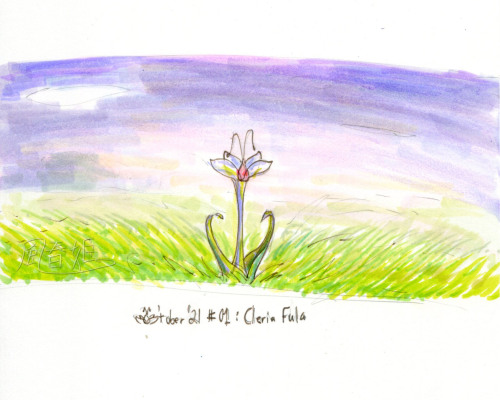
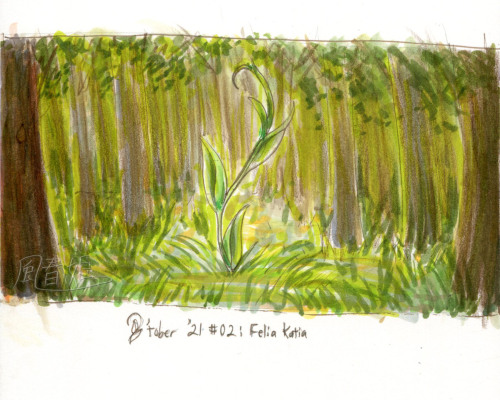
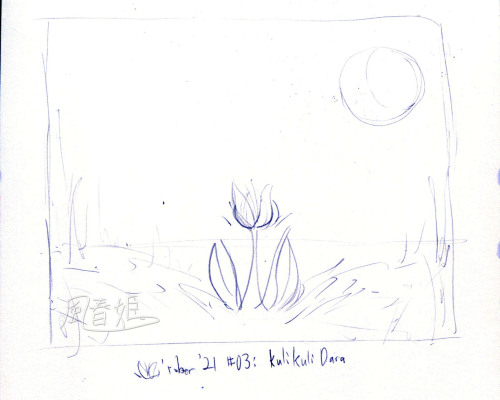
Flowertober is here again but I am tired from working and do not have the energy to go as big as I did last year TwT; I wanted to touch the first two up digitally, and color and ink today’s, but just in case none of that happens I thought I’d post these. Consider them WIPs. I don’t typically post WIPs here but since I don’t post on IG anymore, may as well.
Cleria Fula
Also known as Clera Fula.
Often shows up just before the rainy season on the continent of Wing Alayna (the main continent of the JI stories world). As such, it’s appearance is used to mark the beginning of the season. It has glass-like petals that reflect in the sun. Other than its beauty, not many other uses are known for it.
Felia Katia
A simple vine with sweet leaves vaguely resembling cat ears. It can be found in Wing Alayna, both in the plains and in sunny areas within the Great Buddy Forest; the heart-shaped continent Furheart Iiah; and the eternally sunny continent of Warminia Songlianne.
Kulikuli Dara
The Kulikuli Dara is almost completely clear, and grows in Crescent Minoria, the continent of eternal night where many such other glass-like plants grow. This is said to be caused by the lunar energy given off by the Crescent Minoria Moon, a mysterious entity in the sky that never moves and is always in crescent phase. It is not visible from anywhere else other than Crescent Minoria. How clear a plant is is determined by how much they rely on the moon for energy. Green or black colorations usually mean they rely more on the soil than on the moon, hence why plants from Crescent Minoria grown on other continents are usually greener. As such, the Kulikuli Dara relies almost entirely on the energy of the Crescent Minoria moon, the root system being primarily for anchoring rather than nutrient-absorption. A rather ordinary flower by Crescent Minoria standards, it does not have many other uses besides looking pretty.
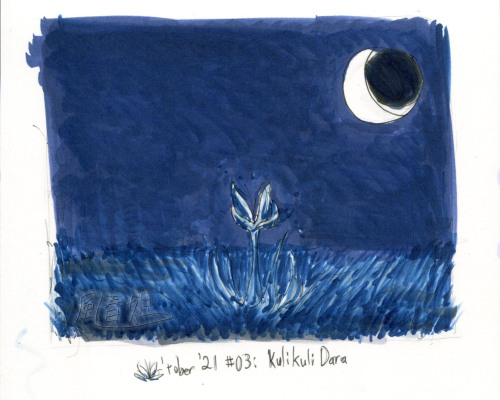
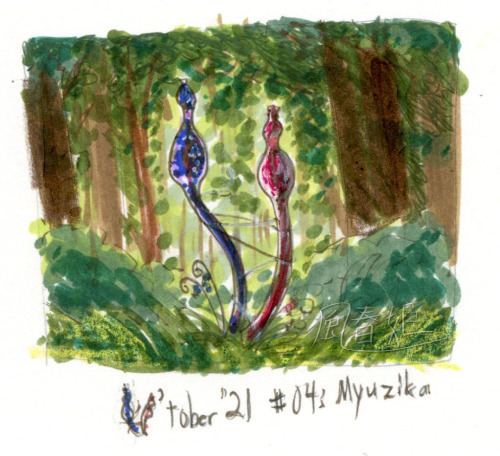
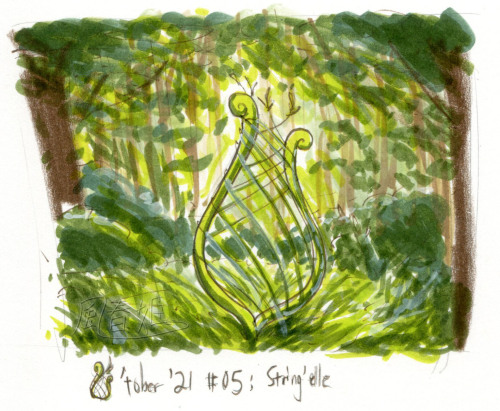
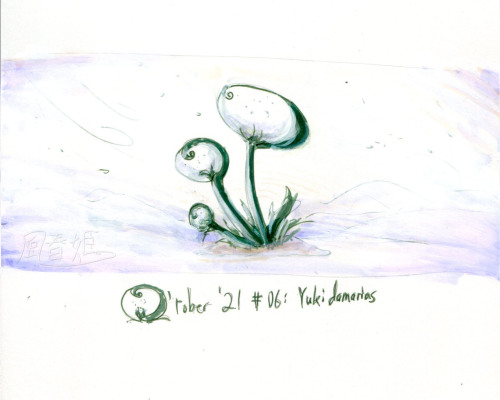

Day off today so you know what I decided to do... finish up these WIPs I hadn’t posted yet! See last time’s post for Kulikuli Dara’s description. The new descriptions are under the cut (thought I should have done this last time... what do you think? Pointless feature, or actually useful in this case? Lemme know I guess).
Myuzika
A relative of the Sweetflute, the Myuzika plant is similarly used as a sort of homegrown orchestra. The plant makes a different sound according to the color of the pipe, and pitch depends on the size of the bulb, which can be made to change over time by adjusting the plant’s environment (more sun = thinner bulb, more shade = larger one). Tendrils grow taut around the two pipes, allowing them to be strummed like an instrument. The curly tendrils at the base can also be tapped for a shaking sound as the hard berries that grow on them bump against each other. There are many other secrets to adjusting the sound of the Myuzika, but only the forest dwellers know all its secrets. The Myuzika can be found natively in the Great Buddy Forest and made to grow in other forests in Wing Alayna such as the Patchimori Forest, though it grows best in its native soil.
String’elle
Another plant in the sylvan symphonic family, the String’elle’s two base vines will grow in completely opposite directions without the help of the plant’s tendrils, which keep the plant taut in a harp-like shape. The plant can be tuned over time by adjusting various elements of its environment, but without artificial intervention it will keep its original tune, allowing the musician to play the instrument in its original form if so desired.
Yukidamarias
A plant found in the depths of Batulia Songlianne, the continent at JI’s north pole (or Non Pona as it is natively called). It was thought for a long time that nothing grows there aside from the occasional rumor of a Song Tulip (the legendary flower for which the continent is named, though whether the plant actually grows there is somewhat shrouded in mystery), but it would seem that the Yukidamarias does as well. Of course... due to the number of odd things reported there, it’s uncertain at best whether the Yukidamarias was found actually growing in the continent’s soil, or in another dimension’s all together. Nevertheless, dimensional abnormalities aside, it may be safe to say that the legendary flower has company on the mysterious frozen continent. Being a relatively new discovery, not much is known about the plant at this time, though it seems quite decorative.
Koshio Flower
The Koshio Flower can be seen growing only during the dry season of Wing Alayna. It spends most of its time unblossomed, but when it does it produces berries that can be dried and ground to make a spice similar to black pepper. The bits that form on its stamen can also be ground and dried to create a substance similar to salt or pepper depending on its color. The same can be said of the rest of the flower. Dried, the white bits form a salt-like material and the black forms something similar to its berries, though with a slightly different flavor.
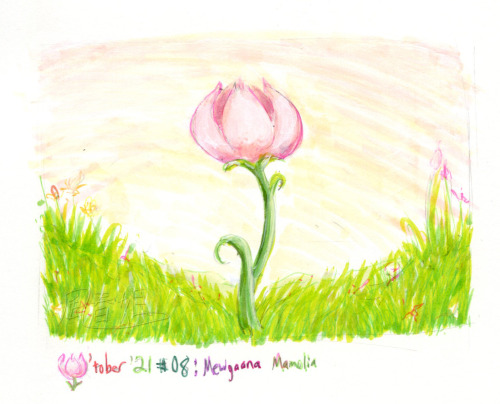
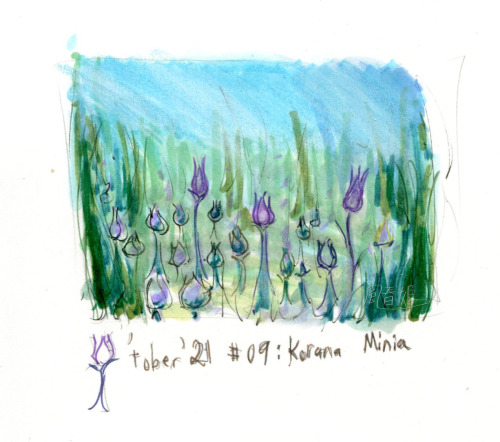
Some flowers for today!
Mewgaana Mamolia
Another member of the Mamolia family, this flower can be found growing on Mewga Island, though its relatives are thought to be found on Furheart Iiah as well. Though primarily decorative, pieces of the petals can be used to make sweeteners for tea. Since the petals are quite large for Buddys, the whole flower is rarely used, instead being left to restore itself after some pieces are taken.
Korana Minia
These strange aquatic flowers can be found growing on the continent of Koraln Sing. They prefer tropical waters, somewhat shallow, so that the tallest of them might be able to reach the surface. Though they can be found growing deeper as well. Though purple is its most common color, it can be found in navy blue, dark green, dark red, and even dark yellow. Its color usually depends on where it grows, with its deep sea cousins usually being darker colors than the shallower water ones. Within their blossoms they grow a somewhat heavy liquid reminiscent of cough syrup. The flavor is not favored by most, so they are mostly grown for beauty.
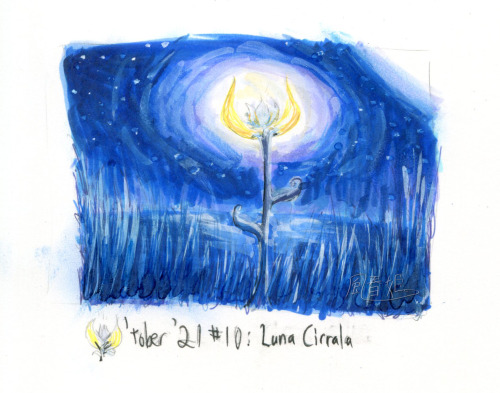
Today’s flower! Finally caught up to one a day. Of course, that won’t last probably with Monday morning right around the corner, but, it’s good to be caught up if only temporarily. :)
Luna Cirrala
The leaves of the flower are more like growths from the stem than actual leaves, but they serve a similar purpose. Like many other Crescent Minoria flowers, the Luna Cirrala gathers energy from the moon and transforms it into liquid, which it stores in the bowl formed by its petals. When there is excess lunar liquid, the flower shuts to prevent waste, and opens again when the flower is not as full anymore. The lunar liquid of Crescent Minoria flowers is a coveted substance, though it is known to have strange effects on Buddys, particularly in tea. Though usually, the substance needs to be mixed or diluted if consumed, since it has an unpleasant taste in higher concentrations. At most though, the effects of consuming lunar liquid mostly include wanting to lay in the moonlight and absorb its lunar rays, and the effect is usually short-lived. Diluted, it may be known to cause dreams about Crescent Minoria or simply a longing for moonlight.
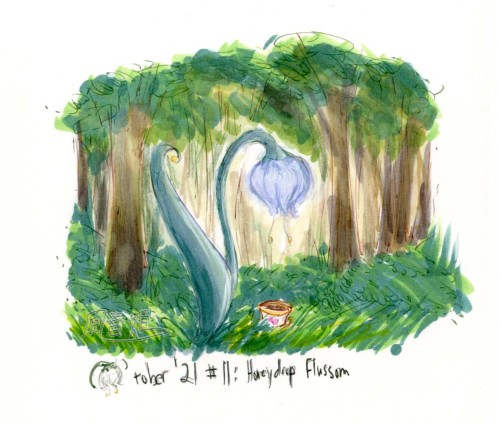
Honeydrop Flussom
Thought to be imported from Crescent Minoria, though it is also speculated that it is a crossbreed of a Rinrin Boubou flower for its nectar-dripping quality, or else a distant relative of the Wingilana Skyplantona for the similar quality of its nectar. Found in the Pachimori Forest, it prefers shady places, and the yellow points on it are thought to change color depending on the conditions it’s in--whether hot, dry, moist, etc--and/or to denote the ‘mood’ of the plant. Its Crescent Minoria heritage though is evident by the sheen of its stem and leaves, as well as the glowing quality the yellow bits have. It is distinct from a Crescent Minoria native flower however in that it does not produce lunar liquid, but only sweet nectar that can be boiled to create a honey-like substance, or consumed raw for a more watery but still sweet taste. Though it has been shown that exposing it to a lot of moonlight will cause the nectar to become milkier, and keep that quality until it has gone without moonlight for a good long period of time. In this way it is thought to be capable of at least blending a lunar liquid-like substance with its nectar, but as it does not seem to consume the lunar liquid like native Crescent Minoria plants do, it is thought perhaps that the need for it was bred out of it, allowing it to freely share whatever substance it creates with whoever is willing to put a container under it. During the Tea Festival, it is common to find wanderers place tea cups under it to collect its nectar to sweeten their tea. The steam from fresh tea is also thought to stimulate nectar production, but this may have more to do with condensation from the steam loosening up crystallized nectar that gathers on the surface of the antennae-like stamen. The petals are also sometimes used as temporary pillows by wanders, as they are quite soft, though usually damp. They can even be sticky from nectar that gets trapped between the petals, so washing and drying them might be the best to produce a feather-like quality.
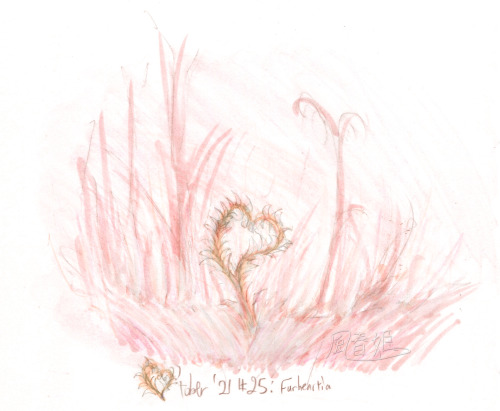
Today's plant! I struggled with how to reinterpret my 2009 design. I still might make a separate plant based off another design I thought of for this plant, but for now... keep reading for more!
Furheartia
The namesake of the continent, Furheart Iiah. It only grows there, but some cultivation attempts have resulted in greener leaves. Flora that grow in Furheart Iiah tend to become pink or tinged pink from the mist that blows in from the surrounding water, which makes the sky and everything else appear pink as well. When the plants that grow on Furheart Iiah are cultivated in foreign soil, they tend to take on greener colors depending on the location. The leaves of the Furheartia plant are beloved for tea, especially if they are imported from their native land, where they maintain a sweet but mellow, calming flavor.
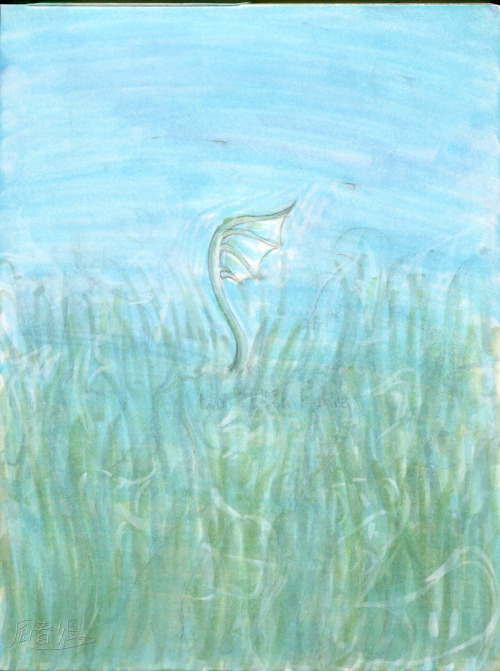
Today's plant, the Finvine! Quirky little plant it is. I probably coulda done more on it buuuut I'm getting to that point where if I want to stay on top of this I gotta be quick. 😅 Keep reading for more flora info!
Finvine
This fin-shaped aquatic plant is found in 4 out the 7 oceans in JI, and plentifully in the Koran Sea. It can even be found in bodies of water on the continent of Koraln Sing, but it is definitely a saltwater plant. It is never found in freshwater. The clear webbing between the rays of the fin are beloved for making gelatin, but they sometimes have a sour taste to them. This seems to be particular to where and how it's grown, though, so some varieties are milder with almost no taste. The Finvine generally prefers shallower waters where it can still receive ample amounts of sunlight. The shallower the better, though it will look quite limp if not fully submerged. Gelatin made from the Finvine is often served as a snack with tea. The main body of the plant is even known to be used in tea, though its salty taste may be disagreeable to some, adding the webbing to it seems to ease the taste a little, and can make for an interesting surprise if the tea is allowed to set.
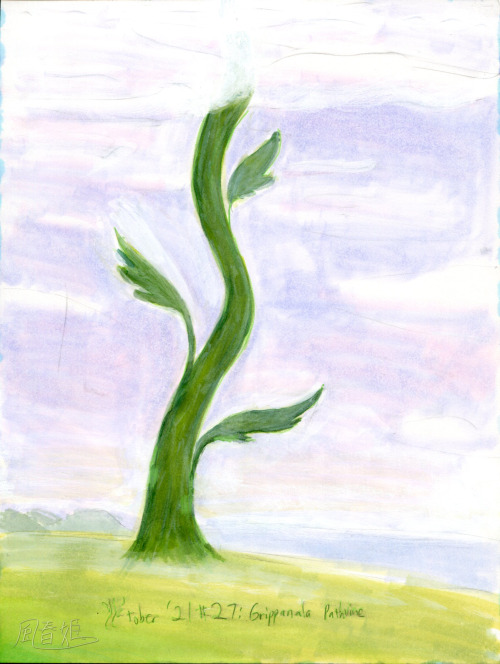
And today we've got some megaflora! Keep reading for more info on this big guy!
Grippanala Pathvine
One of three main types of Pathvines, they are large vines that reach all the way up to Sky Buddy World, making a bridge between the land and sky. Winged Buddys and power cloud services can usually be found here, ready to help you on you're way up. Some adventurous sorts may try to climb the vine themselves or with a group, but it's generally still recommended to go via powercloud--much more enjoyable when you can sit back and enjoy the scenery!
The Grippanala Pathvine is distinguished by the grooves all over the surface of the vine, making it the easiest of the three to climb... in theory. Some may argue that Twis-Tias are superior, but that's a story for another time.
Pathvines can be found sparsely in Wing Alayna. There are even said to be a few found growing from the sea or on remote islands.

Kopp'tura Rainheart
This bright pink flower is found on Reline Ah, the hidden continent of the Flower Buddys. The Kopp'tura Rainheart is a rare flower rumored to cure heartache in those who gaze upon it. Though scarce, its seeds are treasured and carefully sown where a lonely Flower Buddy might gaze on it and find relief.
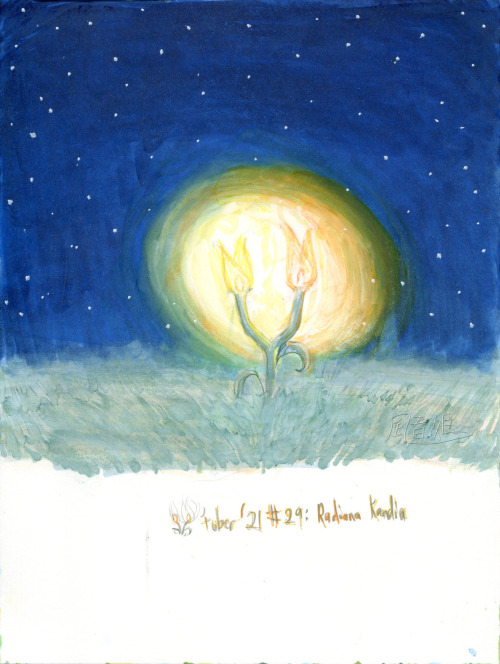
Today's flower~ I wasn't sure I was gonna get it in today but here we are. Now without further ado.... Read on if you please!
Radiana Kandia
Native to Fuline and Reline Ah, the former being the continent of the Dancer Buddys. At certain times of the year they glow brightly yellow or orange--or sometimes both. When Kandias light up often marks the first day of the Dancer Buddy Festival on the continent. Unlike similar clear-petaled plants, the Kandia collects its energy from the stars in addition to the sun and moon. It gives off this energy in radiant displays at certain times.

Sizapop Rizzleri
A rare Wing Alaynan plant with strange properties. The fruit it bears has a hard, clear shell that is soluble in water. Inside is a semi-sweet, fizzy liquid that will make a big splash if the fruit is dunked in hot water. Thus it is preferred to chip off chunks of the outer coating for flavoring instead of trying to dissolve the whole thing in water at once.
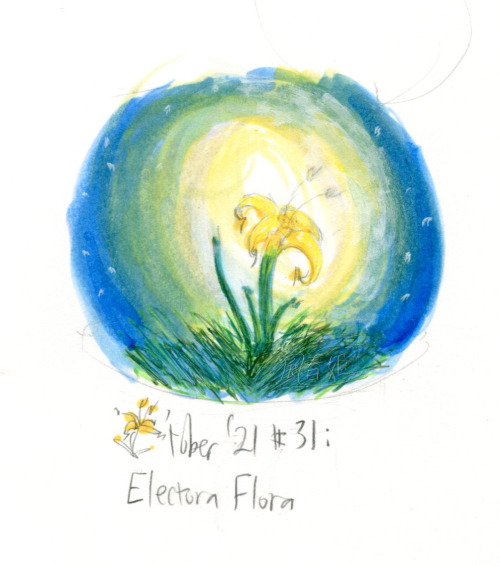
Final flower for this challenge! Seems like my compositions have been shrinking lately. 😅 Ah well, I think my other circle composition did really well two years ago so maybe it will be well-received again? Or does this challenge just not do as well here as on Instagram? So far that's been the vibe. Ahhh... kinda makes me wish it wasn't a garbage platform... Anyways! Onto floral descriptions! Keep reading for more~
Electora Flora
Similar to the Lyta Flora, the Electora flora stores up energy from the sun and gives some of it off at night. The rest it stores in its roots, which can be harvested and used as a power source. Very few know how to do this though, as it requires some technical knowledge. Electora roots are commonly used in the Queen's Palace, as she is one of the few who know how to utilize them.